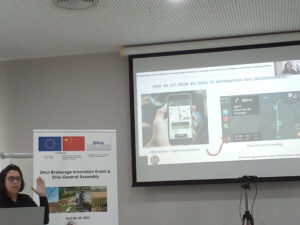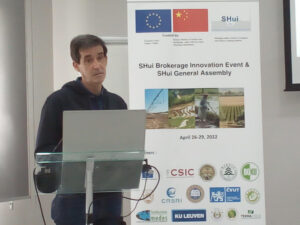SHui’s Innovation Event in Murcia
SHui’s Innovation Event occurred in hybrid format on 26 April in Murcia, immediately prior to our final General Assembly. Our aim was to demonstrate results that could see direct commercial, or freeware, application in industry, ranging from the implementation of best management practices on farm to more holistic determination of crop carbon balance suitable for carbon footprinting methodologies. The event attracted an in-person audience of 30 from within the consortium and local businesses, with a similar number of people registering to attend online.
Following a welcome from project leader José Gómez (CSIC-IAS, Cordoba) and local host Juan José Alarcon (CSIC-CEBAS, Murcia), Beatriz Torralba of the China-Spain Network Alliance provided a brief online history of joint China-Spain funding at a business-to-business level, before focusing on current opportunities that are typically available across a range of sectors ranging from clean energy to medicine. Agricultural enterprises can benefit from this type of funding to enhance the sustainability of their practices by implementing new technologies. Reflecting the importance of the Murcia region as one of Spain’s fruit and vegetable bowls, Wei Sun of Murcia-based company Profinanza gave a case study of regional government co-operation between Murcia and Shandong Province in China, with international business opportunities facilitated by similar challenges such as water scarcity.
These presentations set the stage for more technically focused presentations from the SHui consortium, with tools at various stages of implementation. These included a new model to optimise irrigation scheduling in tree crops, the prediction of vine water status at field level and a new model to allow discrete crop management zones at field or farm scales. Such developments in irrigation scheduling can enhance the efficiency with which irrigation water is used by the crop.
Further issues of water management on farm were the control of water-based gully erosion using check dams, with a cost-benefit analysis introduced to assist farmers in making choices on how to construct these. A prototype Soil/Water app was also presented to enhance farmers ability to contribute ecosystem services to the landscape. Lastly, the benefits of the Green Carbon Tool to define crop carbon capture, based on many years of published data, to help farmers implement on-farm carbon footprinting, were introduced.
After the coffee break (participants were not deterred by the carbon costs of the coffee crop), a range of scientific-commercial collaborations occurring in the Murcia region were introduced. These included forecasting tools for climate-related stresses, the use of non-conventional water sources in irrigation, and a range of technologies to optimise water use in agriculture.
Download the programme here.



